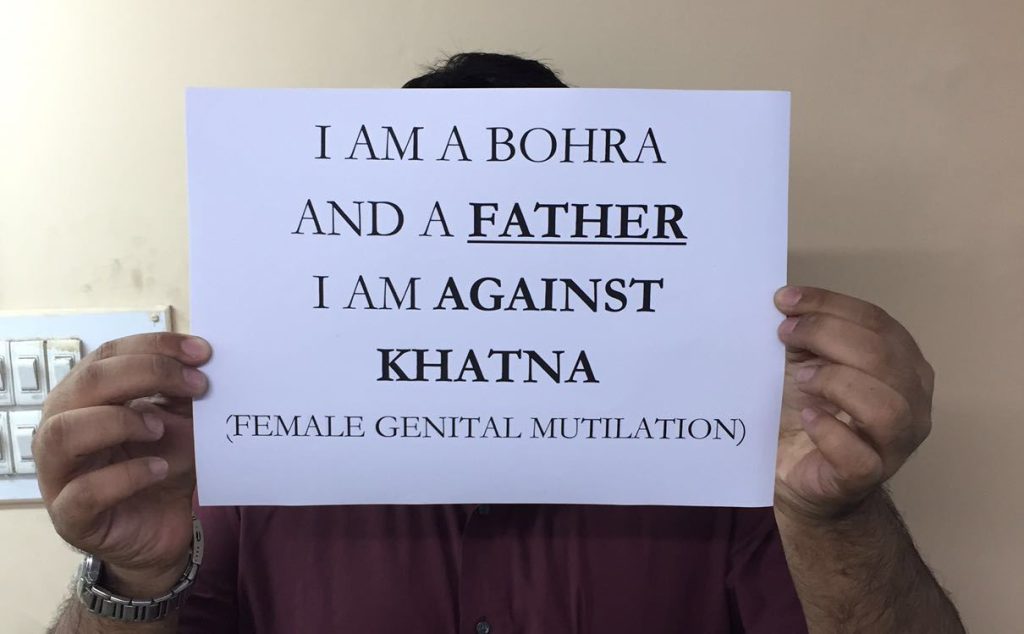Saved by a lie: A story of female genital cutting

By Zainab Khambata Age: 17 Place of residence: Mumbai, India My maternal grandmother prides herself on being the perfect blend of modernity and religion. But when it came to her own daughter who is my mother, in spite of her misgivings, she still fell in line and got my mother circumcised or cut. Ask my grandmother why she did it and the reasons are numerous. Her mother asked her to do it. She lived in a joint family and all the cousins were cut. She didn’t know how to openly defy social norms and say no. The oddly mystifying voice of reason: if everybody is doing it, maybe it is the right thing to do. That is how Bohri women still continue to be cut in this day and age by their mothers and aunts and grandmothers. My mother still remembers the day she was cut as a child very vividly. She wasn’t told anything at all, simply pounced upon by her aunts and a “maasi,” or auntie, who used a razor on her. Then she was asked to rest to let the bleeding stop, given a bar of chocolate, and as a bonus, no school the next day. Life went on for my mother as usual without any mention of the incident or what had transpired. All was good and forgotten until my paternal grandmother started hounding my mom to get me cut. It was this whole maahol, or social environment, where mothers of girls my age were more than happy to play reminder and ask if I was cut yet because they had already had their little girls cut. My mom read about it and realised the physical repercussions of it, the bleeding and scarring, emotional repercussions and trauma, and in some cases, even sexual frigidity. You may never really forget what happens to you even though you are not informed about it at all. Upon inquiry, my mom never got a satisfactory answer as to why girls are cut besides the fact that it’s Sunnat, or encouraged. Some moms said it was for hygiene purposes; others said it would keep a girls’ potentially “sinful” thoughts of a sexual nature at bay. But the final straw was when she was told it may heighten mental and physical intimacy between couples. She realised then that many people have a myriad of confusing reasons to justify cutting. When the pressure became too much from my grandmother and the other moms around her, my mother resorted to the only way she knew to keep me safe, by telling everyone that the deed was already done. My paternal grandmother, who was hell bent on getting me circumcised like all my cousins to uphold her own religious morals and beliefs, made it a point to cross-check with my maternal grandmother whether I was truly cut. My maternal grandmother was smart enough to say yes, mostly to atone to my mom and not let history repeat itself for the sake of my bodily autonomy. In this way, my paternal grandmother was satisfied and she let it rest once and for all. My mom had actually managed to prevent my cutting by telling everyone I had undergone the practice. Ingenious or devious? No matter what, I am grateful.
Why men too must speak out against Khatna

By Priya Ahluwalia Priya is a 22-year-old clinical psychology student at Tata Institute of Social Sciences – Mumbai. She is passionate about mental health, photography and writing. She is currently conducting a research on the individual experience of Khatna and its effects. Read her other articles in this series – Khatna Research in Mumbai. Khatna, by virtue of being related to female anatomy, is often categorized as a women’s issue. However, one must also remember that it is a practice performed on uninformed and unconsenting children. We must move beyond defining it as a child or a woman being violated and look at it as a human being who is being wronged, and therefore the most comprehensive way to describe it would be a human rights violation. Despite it being a human rights issue, it appears as if not many people are willing to speak up against it, even though all people, especially men, need to do so. Within the structure of the Indian patriarchy, men enjoy power not only by virtue of their gender but also by their sheer number in our country. Therefore men can use their position of power to effectively tilt the weights in favor of women who are speaking against Khatna. Although, ideally we expect all men to support us in the endeavour to end Khatna, we should also attempt to understand their hesitancy. Within the Indian patriarchal family structure, the woman is seen as the mistress of the house, in charge of children, while men are seen as masters for all things outside the domain of the house. Therefore any attempt by men to venture into the discussion concerning women’s bodies is seen as ill-mannered and a gross violation of clearly demarcated gender roles. During my research, I met a father who became aware of Khatna and its consequences because he had daughters and therefore vehemently opposed it. He narrated the daily struggle of convincing his own mother against this practice. However, like many other men before and many after him, he was unsuccessful in dissuading the women in his family from continuing it on his daughter. He was blindsided by his mother and given the blanket argument that she knows better for a woman by virtue of herself being a woman. Yet research has shown that with increasing education on khatna, more men are willing to campaign against it. Still, the onus of initiating a conversation on khatna among others lies with the women. Communication between men and women, especially husband and wife, is crucial for the discontinuation of Khatna. A woman I interviewed who had undergone Khatna took this initiative and began a conversation with her husband, which gave her immense strength and helped her protect their daughter from falling into the clutches of tradition. Research too corroborates the same: if more men are are part of the decision making process, the less the likelihood that Khatna would be performed on the girl. The research linked above shows that men who wish to speak up are held back by their limited knowledge on the effects of Khatna.They are unaware of what is removed and what its ramifications are. The primary reason for this ignorance is the lack of conversations about women and their health among family members. This hesitancy to talk about women in front of men comes from the idea that women are equivalent to the family’s honour, therefore talking about aspects of their sexuality may be seen as a violation, thereby a disgrace, to the family’s honour. However, we must move beyond the archaic concept and understand that creating awareness about the ill effects that Khatna has on a woman’s body in no way defiles a family’s honour. After all, what honour can reside in pain? Conversations about Khatna must begin, questions must be asked and collaborative measures between men women must be taken to put an end to this practice. There are several ways to oppose this practice. You may choose to speak out or you may to choose to silently protest; however, if active measures are not taken to resist it, then there is passive consent for the continuation of khatna, and we must understand that every time such consent is given, it means another child is being harmed. Therefore, let us come together for the children and do whatever we can, wherever we can. To participate in Priya’s research, contact her on priya.tiss.2018@gmail.com
ડેટ્રોઈટના ડૉક્ટરની ગિરફ્તારી, ખતના વિષે વાતચીત કરવા માટેની એક તક છે

(આ આર્ટિકલ પહેલા સહિયો દ્વારા તારીખ 14 મે 2017ના રોજ અંગ્રેજીમાં પ્રકાશિત કરવામાં આવ્યો હતો. Read the English version here.) લેખક: અનામી ઉંમર : 33 દેશ : પુણે, ભારત મારા પર ‘ખતના’ની પ્રક્રિયા કરવામાં આવી હોવાનું મને સ્પષ્ટ રીતે યાદ હોવા છતાં મેં મિસાક લીધા પછી, દાઉદી બોહરા સમાજમાં અપનાવવામાં આવતી આ પ્રથા વિષે મેં પ્રશ્ન કરવાની શરૂઆત કરી. આ પ્રથા હંમેશા ખોટી લાગતી હતી પરંતુ, જો મારી માં, બહેન અને સમાજના લગભગ બધા જ લોકો આ પ્રથાને અપનાવતા હોય ત્યારે હું કેવી રીતે પ્રશ્ન ઉઠાવી શકું? હું -મસ્જિદમાં જતી, ઉપવાસ કરતી અને મારા પાસે જેવી અપેક્ષા રાખવામાં આવે તે બધું જ કરતી એક નાની આજ્ઞાકારી બોહરા દીકરી હતી.મિસાક લીધા પછી, એક બોહરા બૈરા તરીકે મારા પરની કઠોર મર્યાદાઓમાં વધારો થવા લાગ્યો. ‘ખતના’ વિષે જાણવાની મારી ઉત્સુક્તાને કારણે હું તે વિષેની માહિતી શોધવા લાગી. પરંતુ પ્રામાણિક્તાથી કહું તો ગુગલમાં શું ટાઈપ કરવું તે પણ મને ખબર નહોતી. અંતે ગમે તેમ કરી જ્યારે મેં તે માહિતી શોધી ત્યારે, આફ્રિકામાં થતાં બૈરાઓના જેનિટલ મ્યુટિલેશનના લોહીલુહાણ ફોટાઓથી મારા કૉમ્પ્યુટરની સ્ક્રીન ભરાઈ ગઈ પરંતુ, બોહરા સમાજમાં આ પ્રથા અપનાવવામાં આવી રહી છે તે વિષે બહુ જ થોડી માહિતી હતી અથવા તો તેવી માહિતી ઉપલબ્ધ જ નહોતી. સ્પષ્ટ છે કે બોહરા સમાજમાં આ બાબત વિષે વાત કરવાની મનાઈ હતી પરંતુ, મારી કૉલેજની એક સહિ હતી જે મારી ઉંમરની બોહરા દીકરી હતી અને મનેતેના પર વિશ્વાસ હતો. તેણીએ કહ્યું કે “મને લાગે છે કે જ્યારે આપણે મોટા થશું ત્યારે આપણને કોઈ સમસ્યા આવી શકે છે અને કદાચ આપણે ક્યારેય સેક્સનો આનંદ નહિં લઈ શકીએ.” એ તેણીના જ્ઞાનની મર્યાદા હતી અને તેણી પણ મારા જેટલી જ કનફ્યુઝ હતી. મારા ગુસ્સામાં વધારો થઈ રહ્યો હતો કારણ કેસમાજના ઘણા નિયમો ખાસ કરીને, બૈરાઓ માટેના નિયમો લોજિક વિનાના, જૂનવાણી અને એકદમ બિનજરૂરી હતા અને તે બધામાં ‘ખતના’ પ્રથા સૌથી વધુ ક્રૂર હતી. મારા પોતાના અનુભવ કરતા, મારી મોટી બહેનની દીકરી જ્યારે સાત વર્ષ (જે ઉંમરે ‘ખતના’ની પ્રક્રિયા કરવામાં આવે છે)ની થઈ તે સમય મારા માટે ખૂબ જ કઠીન હતો. એ બાબત સ્પષ્ટ હતી કે મારી બહેન અને માં બન્ને આ પરંપરાને ચાલુ રાખવાની યોજના કરી રહ્યાં હતા. મારી માસુમ ભત્રીજીને ડરતી જોઈહું એકદમ અસહાય અને નિરાશા મેહસુસ કરી રહી હતી. અંગને કાપ્યાની પછીની રાત્રીએ તેણીને પીડામાં જોઈને મને ખૂબ જ દુઃખ થયું. આ ક્રૂર પ્રથાની આસ્થા ધાર્મિક અને સંસ્કૃતિક રીતે એટલી બધી ઊંડે સુધી છે કે તેને ઉખાડી ફેંકવી ખૂબ જ મૂશ્કેલ છે. જો કોઈ બદલાવ આવવો જોઈએ તો તે સમાજની અંદરથી જ આવવો જોઈએ. પરંતુ, જ્યારે કોઈ એ વિષે બોલવા જ તૈયાર ના હોય તો, કેવી રીતે બદલાવ આવી શકે? અમેરિકામાં નાની દીકરીઓ પર ‘ખતના’ પ્રક્રિયા કરતા ત્રણ ડૉક્ટરોની ગિરફ્તારીના સમચાર ફેલાઈ રહ્યાં હોય, આપણા માટે એ ખૂબ જ અગત્યનું અને મહત્વપૂર્ણ બની જાય છે કે આપણે સમાજની અંદર તે વિષે એકબીજા સાથે વાત કરીએ. મને ખાતરી છે કે આપણા સમાજની અંદર એક પણ બૈરી એવી નહિં હોય જેણે ક્યારેય આ પ્રથા સામે પ્રશ્ન ઉઠાવ્યો ના હોય. અંતે, કેવી રીતે કોઈ માં ઈચ્છાપૂર્વક પોતાની દીકરીને આવી પીડા સહન કરવા દે? મોઢું ફેરવી લઈ, મિશિગનમાં જે કંઈ થયું તેનાથી આપણે કંઈ લેવા-દેવા નથી એવું માનવાના બદલે, આપણે તે વિષે વાત કરી અને પ્રશ્ન ઉઠાવી, તેનો એક તક તરીકે ઉપયોગ કરવો જરૂરી છે. આ સમાજમાં હું મોટી થઈ હોવાથી, હું આ સમસ્યાના દરેક પાસાઓને સારી રીતે સમજું છું, કોઈપણ બોહરા આ બાબતમાં વાત કરવા ઈચ્છતા નથી કારણ કે તે ગુપ્ત અંગો અને બૈરીઓના જાતીય અંગોવિષેની વાત છે અને સેક્સ વિષે વાત કરવાનીમનાઈ છે. પરંતુ, કુટુંબીજનો અને મિત્રોના નાના-નાના સમૂહોમાં સાથે મળી આપણે આ જૂનવાણી પ્રથાને ફરી તપાસવી જરૂરી છે. હવે સહિયો જેવી નોન-પ્રોફિટ સંસ્થાઓ ઉપલબ્ધ છે, જે સમાજના લોકોને માહિતગાર અને શિક્ષિત કરવા વચનબદ્ધ છે. એવા ઘણા વૈજ્ઞાનિક ડૅટા ઉપલબ્ધ છે જે સાબિત કરે છે કે આ પ્રથા અપનાવાથી કોઈપણ પ્રકારનો લાભ થતો નથી. આપણાંમાથી જે લોકો ઈચ્છતા હોય તેમણે, મદરસા અને કૉલેજો, અન્ય સામાજીક સંસ્થાઓ અથવા પીટિશન પર સહી કરવા દ્વારા આપણા અનુભવોને શેર કરવાના માર્ગ શોધવા જરૂરી છે. એવી વ્યવસ્થા સામે આપણે આપણો અવાજ બુલંદ કરવો જરૂરી છે, જે સમાજના લોકો માટે ઘાતક હોય અને ‘ખતના’ જેવી ક્રૂર પ્રથા સમાજના લોકો માટે લાભદાયક છે તેવું બ્રેનવૉશ કરે. પૂરા વિશ્વમાં મારી ઘણી એવીસહિયો છે જેમને નાની-નાની દીકરીઓ છે અથવા તો નજીકના ભવિષ્યમાં તેમને ત્યાં નાના બચ્ચાઓ જન્મ લેશે. અવશ્ય તેઓ તેમની દીકરીઓને પ્રેમ કરે છે અને તેમને આવી ક્રૂરતાનો ભોગ બનવા દેવાનું પસંદ નહિં કરે પરંતુ, રિતરીવાજનું પાલન કરવાની તલવાર માથા પર લટકી રહી હોવાથી, તેની વિરૂદ્ધ ઉભા રહેવાની તાકત બહુ ઓછા લોકોમાં છે. સ્વતંત્ર રીતે વિચાર કરવાનો આપણો અધિકાર છીનવી લેવામાં આવી રહ્યો છે અને આપણે આપણા ધાર્મિક આગેવાનોને પ્રશ્ન કરવાની હિંમત કરતા નથી.પ્રત્યેક દિવસે, વિશ્વભરમાં અનેક દીકરીઓ આ પીડામાંથી પસાર થાય છે અને હંમેશા માટે તેમના જીવનમાં અસરો છોડી જાય છે.સમય ઝડપથી પસાર થઈ રહ્યો છે અને આવી પ્રથા સામે આપણે આપણો અવાજ બુલંદ કરવો જરૂરી છે તેમજ હવે, આ પ્રથાને બંધ કરવા આપણે આપણા ધાર્મિક આગેવાનો સામે માંગ કરવી જરૂરી છે.
